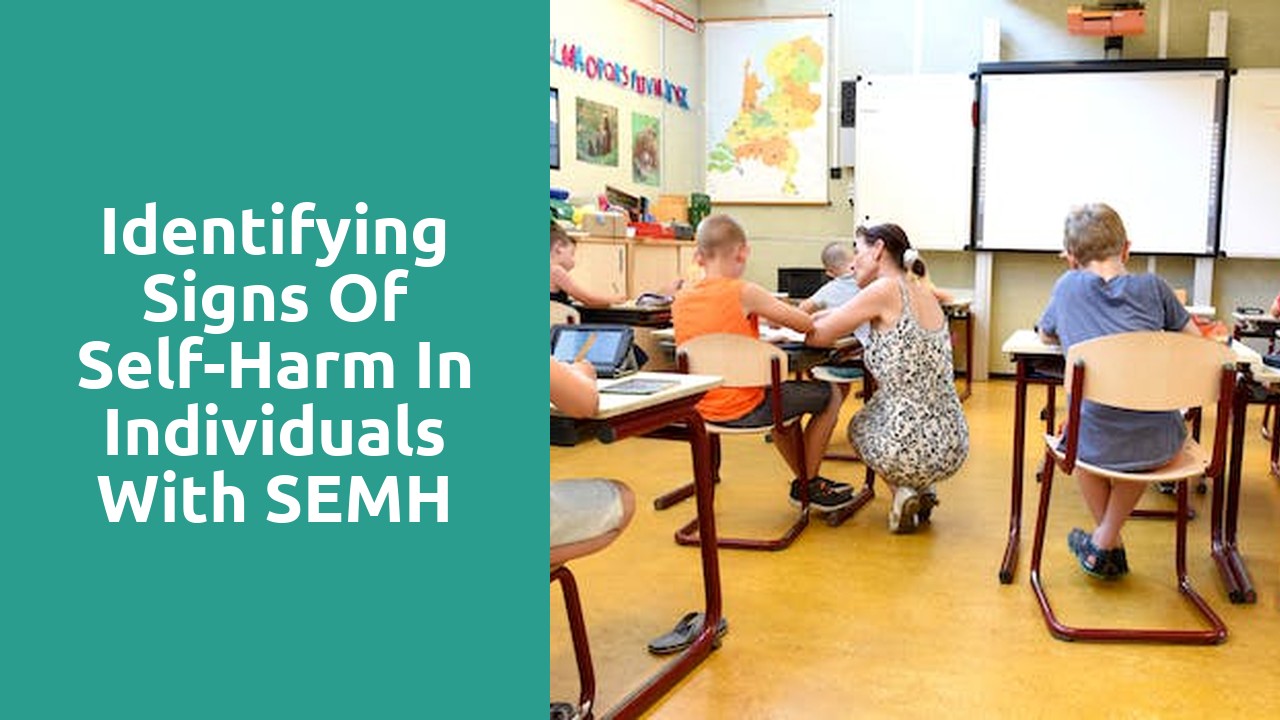

Self-harm is a topic that often remains hidden and misunderstood, particularly in individuals with Social, Emotional and Mental Health (SEMH) difficulties. It is crucial for professionals and caregivers to have the knowledge and skills to recognize the signs of self-harm in these individuals. While it may be difficult to spot, there are several key indicators that can help unveil this invisible battle.
One of the most common signs of self-harm in individuals with SEMH is the presence of unexplained and recurrent injuries. These injuries may include cuts, burns, or bruises, typically found in areas that can be easily hidden by clothing. The individual may offer inconsistent or vague explanations for their injuries, such as accidents or clumsy behavior. Additionally, frequent isolation, withdrawal, and avoidance of certain activities or situations may be an indication that the individual is engaging in self-harm. It is important to approach these individuals with empathy and understanding, as self-harm is often a coping mechanism for intense emotional pain that they may struggle to express in other ways.
Individuals with SEMH (Social, Emotional, and Mental Health) often experience intense emotional pain that goes unnoticed by those around them. This silent suffering can be incredibly isolating, as it is not easily visible or understood by others. The emotional pain experienced by these individuals is complex and multifaceted, and it can manifest in various ways.
One of the primary factors contributing to the emotional pain of SEMH individuals is the feeling of not fitting in or being understood. They may struggle to navigate social interactions and form meaningful relationships, which can lead to a deep sense of loneliness and isolation. Additionally, the challenges they face in managing their emotions often result in overwhelming feelings of frustration, anger, or sadness. These emotions can become overwhelming, leading to a sense of hopelessness and despair.
Self-harm is often perceived as a destructive coping mechanism that individuals with Social, Emotional, and Mental Health (SEMH) issues resort to. It is a complex and multifaceted issue that requires a deeper understanding to effectively address it. Shedding light on these destructive coping mechanisms can help create awareness and dismantle misconceptions surrounding self-harm.
One prevalent form of destructive coping mechanism is self-injury, which involves intentionally inflicting harm on oneself to cope with emotional pain or overwhelming feelings. This can include cutting, burning, scratching, and other forms of self-inflicted violence. It is essential to recognize that self-harm is not a cry for attention but rather an attempt to regulate emotions or gain a sense of control. Although it may seem counterintuitive to an outsider, self-harm can provide temporary relief from emotional distress for individuals with SEMH issues.
Self-harm is a complex and deeply personal issue that affects individuals dealing with Significant Emotional and Mental Health (SEMH) challenges. Recognizing the telltale clues of self-harm in SEMH individuals requires a sensitive and astute approach. While the signs of self-harm may not always be obvious, there are certain indicators that can help professionals and loved ones identify this hidden battle.
One common clue of self-harm in SEMH individuals is the presence of unexplained injuries. These injuries may appear as cuts, burns, or bruises, often found on areas of the body that can be easily hidden. It’s important to note that these injuries might be intentionally disguised, making it essential to examine closer for any inconsistencies or unusual patterns. Moreover, frequent visits to the first aid kit or an excessive amount of bandages in personal spaces can also hint at self-harm tendencies. These physical signs should not be ignored and must be addressed with empathy and understanding.
Self-harm is a deeply complex issue that affects individuals with Social, Emotional, and Mental Health (SEMH) conditions. It is an incredibly difficult subject to address due to the significant stigmatization surrounding it. Breaking the stigma and starting a conversation about self-harm within SEMH communities is vital to ensure that individuals receive the support they desperately need.
Addressing self-harm requires a compassionate and open-minded approach. It is crucial for professionals and caregivers to educate themselves about the underlying causes, triggers, and warning signs of self-harm in SEMH individuals. By understanding the psychological and emotional factors that contribute to self-harming behaviors, we can provide appropriate interventions and create a safe and understanding environment for those who are struggling. Additionally, it is essential to foster open lines of communication, where individuals feel comfortable discussing their feelings and experiences without fear of judgment. Through compassion, empathy, and a commitment to breaking the stigma, we can help SEMH individuals on their journey towards healing and recovery.
Self-harm is a silent battle that many individuals with Social, Emotional, and Mental Health (SEMH) issues face internally. Often driven by intense emotional pain, self-harm becomes a coping mechanism to release that anguish or find temporary relief. However, recognizing self-harm in SEMH individuals can be challenging as they tend to camouflage their wounds, both physical and psychological. The hidden battle they fight is not only physically damaging but also emotionally distressing, leaving them trapped in a cycle of secrecy and pain.
Understanding the underlying reasons behind self-harm in SEMH individuals is crucial to break the barriers of stigma and provide appropriate support. It is important to acknowledge that self-harm is not a cry for attention, but rather a desperate attempt to cope with overwhelming emotions. By shedding light on the destructive coping mechanisms employed, we can begin to address this issue and offer alternative, healthier ways to manage emotional distress. Unmasking the hidden battle of self-harm in SEMH communities is a step towards creating a safe and understanding environment for those who are silently suffering and need our unwavering support.